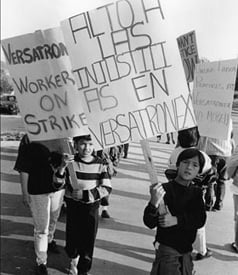Introduction
On January 29, 1993, workers at the Versatronex plant in Sunnyvale, California, filed out of its doors for the last time. Seventeen years have passed since, but there are still electronics workers in Silicon Valley who remember the company’s name. It was the first Valley plant struck by production employees and the first where a strike won recognition of their union.
The struggle of these workers, almost all immigrants from Mexico, Central America and the Philippines, demolished some of the most cherished myths about the Silicon Valley workforce. It showed workers there are like workers everywhere. Under the right circumstances, even in the citadel of high tech’s open shop, people are willing to organize for a better life. “We said at the beginning that if the company was going to close, let them close,” said Sandra Gomez, a leader of the Versatronex strike. “But as long as the plant was open, we were going to fight for our rights.”
Unions have called the electronics industry “unorganizable.” Corporations like IBM, Hewlett-Packard, Intel and National Semiconductor told their workers for years that the company regarded them as a family and that they needed no union. Healthy bottom lines, they said, would guarantee rising living standards and secure jobs. Economists painted a picture of the electronics industry as a massive industrial engine fueling economic growth, benefiting workers and communities alike.

The promises were worthless. Today, many of those giants of the industry own no factories at all, having sold them to contract manufacturers that build computers and make chips in locations from China to Hungary. In the factories that remain in the Valley, labor contractors like Manpower have become the formal employers, relieving the big brands of any responsibility for the workers who make the products bearing their labels.
While living standards rise for a privileged elite at the top of the workforce, they’ve dropped for thousands of workers on the production line. Tens of thousands of workers have been dropped off the lines entirely, as production was moved out of the Valley to other states and countries. Companies long ago eliminated their no-layoff pledge. Permanent jobs became temporary and then disappeared entirely. The image of the clean industry was undermined by toxic contamination of the Valley’s water supply and a high occurrence of chemically induced industrial illness.
Despite these obstacles, however, for three decades Silicon Valley was as much a cauldron of new strategies for labor organizing as it was for corporate management of the workforce. Workers developed important tactics to oppose inhuman conditions. Some unions, like the janitors, wielded those tactics with remarkable success. For production workers in the plants themselves, however, the road was harder and they often seemed to accept the industry’s mythology that they either couldn’t or wouldn’t organize.
The Development of the High-Tech Workforce
One of the oldest myths about Silicon Valley is that its high-tech innovations were the brainchildren of a few, brilliant white men, who started giant corporations in their garages. In fact, the basic inventions that form the foundation of the electronics industry, especially the solid-state transistor, were developed at Bell Laboratories, American Telephone and Telegraph, Fairchild Camera and Instrument and General Electric. These innovations were products of the cold war – of the race in arms and space that began after World War Two. Long before the appearance of the personal computer, high-tech industry grew fat on defense contracts and rising military budgets. Its cold war roots affected every aspect of the industry, from its attitude toward unions to the structure of its plants and workforce.
As the electronics industry began to grow in the 1950s, a fratricidal struggle within the US labor movement led to the expulsion of many unions and union members for their left-wing politics. One byproduct of that struggle was the near destruction of the union founded to organize workers in the electrical industry – the United Electrical, Radio and Machine Workers of America (UE). General Electric Corp. in particular helped ensure the fragmentation of the electrical industry workforce among 13 different unions, with a great proportion outside any union at all. As a result, while the new high-tech industry was growing, the ability of electrical and electronics workers to organize unions in the expanding plants fell to its lowest point since the early 1930s.
From the beginning, high-tech workers had to face an industry-wide anti-union policy. Robert Noyce, who participated in the invention of the transistor and later became a co-founder of Intel Corp., declared that “remaining non-union is an essential for survival for most of our companies. If we had the work rules that unionized companies have, we’d all go out of business. This is a very high priority for management here. We have to retain flexibility in operating our companies. The great hope for our nation is to avoid those deep, deep divisions between workers and management which can paralyze action.”
The expanding electronics plants were laboratories for developing personnel-management techniques for maintaining “a union-free environment.” Some of those techniques pioneered in Silicon Valley, like the team-concept method for controlling workers on the plant floor, were later used to weaken unions in other industries, from auto manufacturing to steelmaking.
Another co-inventor of the transistor, William Shockley, won renown as a partisan of theories of the racial inferiority of African-Americans. As Shockley, Noyce, and others guided the development of the industry in Silicon Valley, they instituted policies that effectively segregated its workforce. In electronics plants, women were the overwhelming majority, while the engineering and management staff consisted overwhelmingly of men. Immigrants from Asian and Latin American countries were drawn to the Valley’s production lines. Engineering and management jobs went to white employees.
By the mid-1990s, Asian workers made up 30 percent of the skilled production workforce, 47 percent of the semiskilled workforce and 41 percent of the unskilled workforce. Latinos constituted 18 percent of skilled workers, 21 percent of semiskilled workers and 36 percent of unskilled workers. Both groups together were only 17 percent of management employees and 25 percent of professional and engineering employees. The same picture held true for women. While 23 percent of management employees were women and 29 percent of professionals, women were 80 percent of clerical employees, 40 percent of skilled workers, 60 percent of semiskilled workers and 50 percent of unskilled workers. The picture painted by these statistics is still largely accurate today.
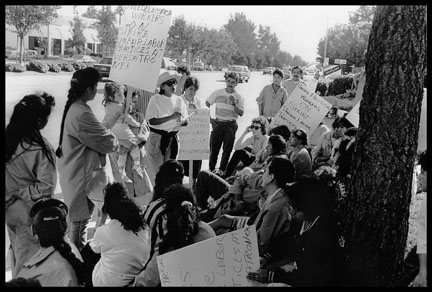
African-American workers were frozen out almost entirely. Although unemployment in the African-American communities of Oakland and East Palo Alto, within easy commuting distance of the plants, has remained at depression levels, African-Americans are not above 7.5 percent of the workforce in any category and below 3 percent in management and engineering.
Karen Hossfeld, a sociologist at San Francisco State University, who has written extensively on the status of women in high-tech industry, explains the segregation as a conscious decision on the part of manufacturers. “Employers assume foreign-born women will be unlikely to agitate for pay hikes,” she says.
The First Effort – Organizing Semiconductor Workers
The historic base for organizing activity among high-tech workers for many years was the workforce in the semiconductor plants. Starting in the early 1970s, workers began to form organizing committees affiliated to the UE in plants belonging to National Semiconductor, Siltec, Fairchild, Siliconix, Semimetals, and others. Most of these were semiconductor manufacturing plants or factories that supplied raw materials to those plants.
Amy Newell helped start a rank-and-file organizing committee at the Siliconix plant in the early 1970s. Two decades later she became the UE’s national secretary-treasurer, the highest-ranking woman union officer in the US at the time. After leaving the UE, for many years she headed the AFL-CIO’s Central Labor Council in Monterey County, just south of Silicon Valley. She recalls that “although I got my job at Siliconix by chance, we concentrated on the larger plants because the level of capital investment by the companies was so large there. They were the big players and we wanted to go for the heart. Nevertheless, it was very hard organizing a union in those plants, because the feeling of powerlessness among the workers was so difficult to overcome.”
To organize unions in the large electronics manufacturing plants, Newell says, “it seems obvious that there has to be a long term effort and commitment, with an industry-wide approach. It’s hard to imagine organizing any of the plants without a much larger movement among workers in the industry as a whole and in the communities in which the workers live.”
By the early 1980s, the UE Electronics Organizing Committee had grown to involve a signed-up core membership of over 500 workers, who were participants in a number of union campaigns.
Romie Manan was an active member of the committee through the early 1980s, organizing Filipino immigrant workers on the production lines at National Semiconductor. Manan remembers that the union published 5,000 copies a month of a newsletter, The Union Voice, in three languages – English, Spanish and Tagalog. Workers handed it out in front of their own plants or in front of other plants if they were afraid to make their union sympathies known to their coworkers. “A few of us were aboveground, to give workers the idea that the union was an open and legitimate organization, but most workers were not publicly identified with the union,” he recalls.
The union depended on the activism of workers in the plants themselves. For a number of years, there was no union staff person assigned to Silicon Valley, and at the height of its activity, a single union organizer, Michael Eisenscher, was the committee’s link to the national union, running the union mimeograph machine in his garage. The strategy of the UE Electronics Organizing Committee envisioned a prolonged struggle to win the loyalty and commitment of a majority of workers in the semiconductor plants. Committee members challenged the companies on basic questions of wages, working conditions, discrimination and job security. It won cost-of-living raises, held public hearings on racism and firings in the plants and campaigned to expose the dangers of working with numerous toxic chemicals.

Nicacia Amaya’s sign accuses one of Versatronex’s customers, Digital Microwave Corp., of stealing her children’s future by continuing to do business with the struck plant.
Eventually, the semiconductor manufacturers, especially National Semiconductor, fired many of the leading union activists and the committee gradually dispersed as its members sought work wherever they could find it. The main strategic question, which the committee sought to answer, remains unresolved. In large electronics manufacturing plants, employing thousands of workers, the process of organization doesn’t take place overnight. For a long period of time, union-minded workers, especially worker-organizers, were a minority. Their organization had to be active on the plant floor, winning over the majority of workers by fighting around the basic conditions that affected them. In the process, it had to be able to help its members survive in an extreme anti-union climate.
This long-term perspective is very different from the organizing style of most unions today. Many view union organizing as a process of winning union representation elections administered by the National Labor Relations Board. Others try to use outside leverage to force management to remain neutral while workers sign union cards and eventually negotiate a contract. While both strategies have something to offer electronics workers, especially over the long haul, they don’t deal directly with the situation that exists on the plant floor. The prospects of successfully fighting a union election campaign inside a semiconductor or computer-building plant are extremely remote. The huge corporations have insulated themselves from their production workforce so well that outside pressure has little effect on them. In reality, most unions have simply abandoned the idea of helping workers in those plants to organize at all, saying that they are “unorganizable.”
Toxic Contamination and Runaway Jobs
Despite its lack of success in organizing permanent unions in the plants and winning bargaining rights, the UE Electronics Organizing Committee was a nexus of activity from which other organizations developed.
The Santa Clara Committee on Occupational Safety and Health (SCCOSH), originally founded by health and safety activists in the late 1970s, included members of the UE committee who left the plants to work on its staff. It built broad ties with other unions, occupational health and safety experts and community activists. It fought successfully for the elimination of such carcinogenic chemicals as trichloroethylene and for the right of electronics workers to know the hazards of toxics in the workplace. SCCOSH sponsored the formation of the Injured Workers Group, which organized workers suffering from chemically induced industrial illness.
Under pressure from SCCOSH and other health and safety groups, the Semiconductor Industry Association (SIA) sponsored a study of 11 plants in 1992, to disprove any connection between the high miscarriage rate among women in the industry and their job conditions. The SIA study, however, proved exactly the opposite. It found a direct connection between the use of ethylene glycols and high miscarriage rates. SCCOSH then began a Campaign to End the Miscarriage of Justice, to force an end to the use of these chemicals.
“When we talk about organizing,” explained Flora Chu, then the director of SCCOSH’s Asian Workers’ Program, “we have to talk in a new way. Many immigrants, for instance, aren’t used to organizing in groups at work. SCCOSH helps to introduce them to the concept of acting collectively, instead of as individuals, when they want to confront their employer on issues relating to chemical use. The organization of unions in the plants will benefit from this and help workers, if unions are sensitive to the needs and culture of immigrants.”
The Silicon Valley Toxics Coalition also grew out of the health and safety campaigns that ripped apart the image of the “clean industry.” The Toxics Coalition won national recognition when it exposed the large-scale contamination of the water table throughout Silicon Valley by electronics manufacturers. Coalition activists organized the communities surrounding the plants and forced the Environmental Protection Agency to add a number of sites to the Superfund cleanup list.
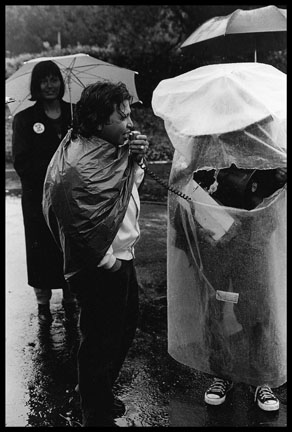
Janitors’ organizer Lino Pedres calls on strikebreakers to leave work and respect the strike.
Communities elsewhere in the country became aware that jobs brought by the construction of new electronics plants came at a potentially high cost. In many areas, environmental standards and requirements were increased as a result. The Toxics Coalition also worked with the local labor movement and city governments to force manufacturers to list the chemicals used in the factories and develop plans for handling the possible release of toxic chemicals in fires or other disasters.
The UE committee’s last campaign in 1982 foretold much of the future for semiconductor workers. The committee tried to mobilize opposition to the industry’s policy of moving production out of Silicon Valley. In 1983 the plants employed 102,200 workers; they employed only 73,700 workers ten years later. While the number of engineers and managers increased slightly, job losses fell much more heavily on operators and technicians. “What this really meant,” said Romie Manan, “was that Filipino workers in particular lost their jobs by the thousands, more than any other national group.” Manan lost his job as National closed its last mass production wafer fabrication line in the Valley in 1994.
Rapidly evolving technology in electronics production has a big effect on the lifespan of semiconductor plants. A wafer fabrication line, the basic unit of the production process, has a useful life of about ten years. Then, it can no longer compete with newer, more automated lines, which process larger wafers. When technology evolves so rapidly, semiconductor companies must build new plants and new fabs constantly. For workers whose jobs are dependent on the production line, the location of these new plants and lines is a life-and-death question.
Howard High, a public relations spokesperson at Intel Corp., stated flatly, “I really don’t think we’ll see more semiconductor manufacturing in Silicon Valley in the future.” In 1993, Intel built a new $1 billion plant in Rio Rancho, New Mexico, instead of California. High said that the company decided to locate it outside Silicon Valley because New Mexico offered Intel an industrial revenue bond worth $1 billion, to help finance the plant’s construction. California put in a bid as well, but couldn’t match the subsidies offered by New Mexico.
Manan and other semiconductor workers believed that lower wages were another determining factor. “The truth of the matter is the company can hire workers in New Mexico much more cheaply because wages there are much lower,” he said. “New workers also earn a starting wage, around $6-7/hour, unlike those of us with many years in the plants here, who earned more as a consequence. That’s why National and other companies wouldn’t allow Silicon Valley workers to transfer to the other plants.”
Whether the main factor was wages or industrial revenue bonds, large electronics companies were able to initiate bidding wars, in which communities around the country competed to win new production facilities by guaranteeing a combination of cost savings, relaxation of regulations and direct tax subsidies. In Silicon Valley, that competition created a two-tier workforce. The more permanent jobs in the large manufacturing plants began disappearing. But contractors who provided services to the large companies, from janitorial and foodservices to the assembly of circuit boards, employed more workers every year.
The New Wave – Organizing the Contractors
Conditions for janitors and contract assemblers are a far cry from those associated in the public mind with high-tech manufacturing. Workers losing jobs on wafer fabrication lines in the semiconductor plants made as much as $11-14 per hour for operators and more for technicians, even in the early 1990s when the minimum wage hovered just above $4 per hour. Companies provided medical insurance, sick leave, vacations, and other benefits. By contrast, contract assemblers and nonunion janitors are paid close to the minimum wage, have no medical insurance and often no benefits at all.
In effect, workers in the service and sweatshop sector fought to win wages and benefits close to the level of those achieved by semiconductor workers at the time of the previous peak in organizing activity ten years before. Over that period of time, the workforce of Silicon Valley had taken a giant step backward. The decline in living standards made the service and sweatshop economy in Silicon Valley the subsequent focus for workers’ organizing activity.
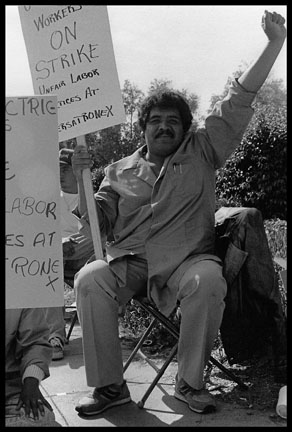
The spark that set off this second wave was the campaign to organize the janitors at Shine Maintenance Co., a contractor hired by Apple Computer Corp. to clean its huge Silicon Valley headquarters. Over 130 janitors joined Service Employees International Union (SEIU) Local 1877 during an organizing drive at Shine in the fall of 1990. When Shine became aware that its workers had organized, it suddenly told them they had to present verification of their legal residence in order to keep their jobs. The company cited the requirement, under the employer sanctions provision of the Immigration Reform and Control Act, that it maintain written proof of employees’ legal status. When almost none of Shine’s workers could present the required documents, they were terminated. The company never questioned the documentation provided by workers when they were hired or at any other time until the union drive began.
Shine’s actions ignited a yearlong campaign, which culminated in the signing of a contract for Apple janitors in 1992. After the firings, the union called a meeting of activists in San Jose’s large Latino community, along with church and political figures. “We told them that we had taken our struggle as far as we could – that the labor movement is limited because the law hurts workers who want to organize more than it helps them,” explained Mike Garcia, president of Local 1877. “So a community coalition went to picket when our union couldn’t, supported the workers with a hunger strike and started a boycott of Apple products.” That community effort grew into the Cleaning Up Silicon Valley Coalition.
According to Garcia, understanding the position of immigrant workers was an important part of the successful campaign at Shine and Apple. “Apple spends a lot of money on its image,” he explained, “and our strategy attacked it. We helped people to understand that the company was exploiting immigrant janitors and we forced Apple to take responsibility – we told Apple ‘it’s your system – you control the contractors; you’re causing the exploitation.” Other employers in the Valley closely watched the campaign at Shine and Apple. Using the same strategy, the union went on to win a contract for janitors at Hewlett-Packard Corp., an even larger group than those at Apple. The momentum created in those campaigns convinced other nonunion janitorial contractors to actively seek agreements with Local 1877 and over 1,500 new members streamed into the union.
In September of 1992, janitors were joined by electronics assembly workers at Versatronex Corp., who used a similar strategy to organize against the sweatshop conditions prevalent in contract assembly factories. The starting wage at the plant was $4.25 – the minimum wage at the time – and employees with over 15 years earned as little as $7.25. There was no medical insurance.
Sergio Mendoza worked in the “coil room,” making electrical coils for IBM computers for seven years. The work process involved dipping the coils into chemical baths and drying them off in ovens. “They never told us the names or the dangers of the chemicals we worked with,” he recalled. “Sometimes the vapors were so strong that our noses would begin to bleed.” The conditions in the “coil room” were very different from those at the facilities IBM had at the time in South San Jose, which it referred to as a “campus.” IBM’s orders gave a big boost to Versatronex’ contract assembly business for 20 years and workers recalled seeing IBM inspectors frequently visiting their plant.

Contract assembly provides a number of benefits for large manufacturers like IBM. Contractors compete to win orders by cutting their prices and workers’ wages, to the lowest level possible. Manufacturers can place new orders on a moment’s notice when production demands increase, without having to hire any workers themselves. When production needs decrease, they can simply cut orders. If workers lose their jobs, the manufacturer has no responsibility for them.
The contract assembly system, then in its infancy, has come to dominate high-tech industry today. Corporations like Hewlett-Packard and Apple have no factories at all. Their entire production is carried out by contract manufacturers in plants around the world.
Workers at Versatronex called in the UE after they had already organized themselves to protest conditions and as they were preparing to stop work to demand changes. When the company heard rumors of the stoppage, managers held a meeting to head off the planned action. One worker, Joselito Muñoz, stood up and declared to company supervisors, “se acabo el tiempo de la esclavitud,” which means, “the time of slavery is over.” Muñoz was fired two days later, and on October 16, Versatronex workers went on strike to win his job back.
In the course of their strike, workers focused on a large customer whose boards were assembled at Versatronex – Digital Microwave Corp (DMC). The year before the strike, DMC closed its own manufacturing facility in Scotland. Its orders became a main source of work for the Versatronex plant. At the high point of the six-week Versatronex strike, ten women went on a hunger strike outside DMC’s gleaming office building. For four days, they fasted to dramatize their effort to hold the manufacturer responsible for their working conditions. Male strikers supported them by setting up tents and living around the clock on the sidewalk outside the corporate headquarters. Word of their action spread like a shockwave through the Valley’s immigrant Mexican community.
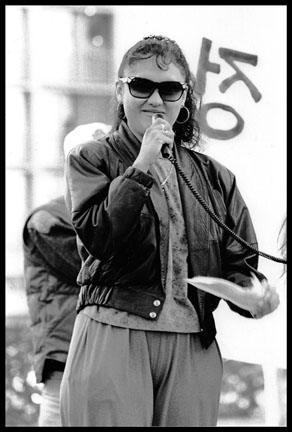
Versatronex striker Sandra Gomez speaks at a rally.
“We went on a hunger strike against Digital Microwave Corporation because they send work to Versatronex and then close their eyes to the conditions we work in,” explained hunger striker Margarita Aguilera. Aguilera was a student activist in Mexico and used her experience in student strikes to come up with tactics for organizing workers at Versatronex. One was the hunger strike. “It is not uncommon for Mexican workers to fast and set up ‘plantons’ – tent encampments where workers live for the strike’s duration,” said Maria Pantoja, a UE organizer from Mexico City. “Even striking over the firing of another worker is a reflection of our culture of mutual support, which workers bring with them to this country. Our culture is a source of strength for our union.”
As workers at Versatronex were striking for their union, Korean immigrants at another contract assembly factory, USM Inc., launched a similar struggle for justice. Their employer closed their factory owing them two weeks pay, a common event in the lives of contract laborers. USM workers turned to the Korean Resource Center, a service agency in Silicon Valley’s Korean community. Through the winter and the following spring, they organized a series of demonstrations in downtown San Jose against Silicon Valley Bank, which took over the assets of the closed factory and refused to pay the workers. According to Bumshik Eom, a KRC staff member, “the bank said the workers had no power,”
In the course of the conflict, USM workers formed an organization to provide services, job referrals and education programs to Korean immigrants. “Although some workers wanted to form a union, others brought a belief from Korea that unions are communist,” Eom said. “But workers could agree on forming an organization to help each other and to educate each other on their rights.”
Despite differences in union experience among different immigrant nationalities, almost all immigrant workers are on the bottom in terms of wages, working conditions and quality of life. The Versatronex strike and movements among other South Bay workers were upheavals from below, according to Pantoja. “They shone a light on conditions that are like apartheid for immigrant sweatshop workers.”
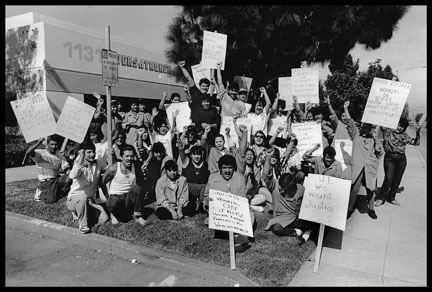
Silicon Valley organizers all emphasize that immigrants have a harder time challenging employers because they are often unaware of their rights as workers. In addition, employer sanctions and the threat of deportation make the risk of losing a job much higher than for non-immigrants. That vulnerability to the employer and the weakness of legal protections was cited by SEIU’s Justice for Janitors as a reason for not relying on National Labor Relations Board (NLRB) elections. To overcome the obstacle, the union mobilized community pressure through marches, demonstrations, sit-ins, and other mass actions. In that context, the militant history of many immigrants became a positive advantage, according to Eliseo Medina, SEIU executive vice president. “Immigrants from Central America,” he said, “have a much more militant history as unionists than we do and the more militant workers are, the more the union can do.”
New Obstacles and New Tactics
Many unions have lost faith in the ability of workers to use the legal process for winning union representation, especially the NLRB election process. One worker out of every ten involved in a union organizing drive gets fired as a result, according to the AFL-CIO. Employers can shift production, spend hundreds of thousands of dollars on expert anti-union consultants and use the fear of job loss to exert enormous pressure on workers. Although often technically illegal, these hardball tactics go effectively unpunished by the NLRB’s legal process.
Tactics like those used at Apple, USM and Versatronex have been at the cutting edge of the labor movement’s search for new ways to organize. They rely strongly on close alliances among workers, unions and communities to offset the power exercised by employers. Often, though not always, they use organizing tactics based on direct action by workers and supporters, like civil disobedience, rather than on a lengthy propaganda war during a high-pressure election campaign, which companies frequently win.
Grassroots tactics responded well to the basic issues of low wages and bad conditions prevalent in contract and sweatshop employment, and contributed to giving the Silicon Valley campaigns the character of a social movement. As workers organize around conditions they face on the job, they learn organizing methods they can use to deal with issues of immigration, discrimination in the schools, police misconduct, and other aspects of daily life in immigrant communities.
The movement among contract employees took an important step when janitors united with workers from Versatronex and USM in a march through downtown San Jose, demanding an end to exploitive conditions for immigrants. Workers, unions and community organizations recognized that they were better off challenging high-tech industry together than as single organizations.
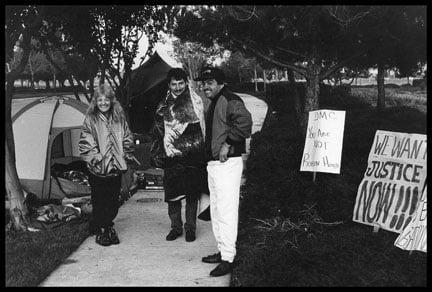
Versatronex strikers at their tent encampment on the sidewalk in front of one of Versatronex’s biggest customers, Digital Microwave Corporation.
That point was brought home when Versatronex closed its plant in January 1993. Workers had ended their strike the previous November and filed a petition for a representation election in December. “When the company knew they would lose the election, they decided to close,” Pantoja said. “In an industry as anti-union as electronics, I assume that the manufacturers told Versatronex that the company would no longer get any orders if workers successfully organized a union in the plant.”
Electronics manufacturers have been forced over the years to permit outside contract services, like janitorial services and in-plant construction, to be performed by union contractors. Nevertheless, the industry has drawn a line between outside services and the assembly contractors who are part of the industry’s basic production process. In one section, unions could be grudgingly recognized; in the other, they could not.
Workers, communities and unions need a higher level of unity to challenge high-tech industry successfully and to win the right for workers to organize effectively in the plants. Combined organizing efforts, in which unions seek to organize many contractors at the same time, would limit the ability of employers to cut off a single contractor like Versatronex.
A step toward this kind of unity was taken when unions and community organizations came together in 1993 to protest plans by the high-tech industry to impose its own blueprint for economic development on the future of Silicon Valley. The industry effort, called Joint Venture: Silicon Valley, brought together a coalition of over 100 industry executives and representatives of local government bodies. Together, they projected initiatives to shape public policy on subjects like regulatory relaxation, education and resources for technological development.
A labor/community coalition was formed to respond to Joint Venture’s agenda. It drew up a Silicon Valley Pledge, calling on companies to respect the rights of workers and communities and to deal with them as equals. Ernestina Garcia, a longtime Chicano community activist in San Jose, explained, “we’ve never felt that the electronics industry had the interests of our communities at heart. If they plan the future of the Valley, they’re going to do it for their benefit, not ours.”
“What we have here are different interests,” said Jorge Gonzalez, who chaired the Cleaning Up Silicon Valley Coalition. “Economic development in Silicon Valley has historically served the interests of the few. We want development that serves the interests of the many. Just protecting the competitiveness and profitability of big electronics companies will not necessarily protect our jobs and communities, a safe environment, our right to form unions or our schools and public services. We don’t want anyone telling us that higher profits for big electronics companies will give us jobs and that we should be happy with that.”
After their experiences at Apple, Versatronex and other Valley factories, unions also tried to organize a much broader, more comprehensive campaign, called the Campaign for Justice. Initiated by the janitors’ union, instead of concentrating on a single contractor or organizing plant by plant, it aimed at the whole low-wage contract workforce. While employers could close a single plant in response to organizing activity, organizers argued, closing many plants would be much more difficult. John Barton, the campaign’s coordinator, declared, “We’re going to hold manufacturers responsible for their contractors.”

Rather than competing against each other, drawing jurisdictional lines in the sand among the Valley’s unorganized workers, the Campaign for Justice was based on union cooperation. Four separate international unions, including the janitors’ union, the Teamsters, the hotel and restaurant workers and the clothing workers, formed an overall strategy committee and contributed researchers and organizers to a common pool. Two community representatives also sat on the strategy committee.
Ultimately, however, the pressure for immediate results led unions other than the janitors to pull out. Local 1877 pushed forward with a drive aimed at the landscape gardeners in the Valley’s industrial parks. The campaign won the support of many workers, some of whom were fired in the process. Workers marched through the streets and brought community pressure to bear on contractors and their corporate clients. Eventually, however, the campaign was folded into the effort to renew union contracts for the Valley’s janitors.
When the anti-immigrant Proposition 187 made the 1994 ballot, janitors joined other immigrant-based unions and immigrant community organizations in the statewide effort to defeat it. Those efforts led to long-term relationships between unions and immigrant communities. At the initiative of the janitors, SEIU called for repeal of employer sanctions, as did the garment unions and the state labor federation. Six years later, that coalition led a successful effort to get the AFL-CIO nationally to call for the repeal of sanctions, a key step in reordering labor’s relationship with immigrant workers.
For a number of years afterward, the South Bay Labor Council of the AFL-CIO mounted an effort to run a temporary employment agency for high-tech workers. This effort gave the labor movement a presence among some workers, but it concentrated on high-skilled employees rather than production workers on the lines. Unions had no presence in the plants themselves and didn’t seek to mount factory-floor campaigns for improvements in conditions.
Electronics Companies Press for Political Changes
After President Clinton was elected in 1992, high-technology companies began using their support for his campaign to press for changes in labor law to bring it into line with what they called new realities. Unions and workers also wanted changes, including enforcement of existing rights and new legislation to take into account the proliferation of contract and temporary work.
The Clinton administration set up a commission to review labor law reform, the Commission on the Future of Labor-Management Relations, called the Dunlop commission for its chairman, John Dunlop, labor secretary under President Nixon. But its mandate, rather than reinforcing workers’ union rights, was “to make recommendations concerning what changes, if any, are needed to improve productivity through increased worker-management cooperation and employee participation.” The Dunlop commission’s key hearing in Silicon Valley was convened by Joint Venture: Silicon Valley at the request of Marty Manley, the Department of Labor’s deputy secretary for the American Workplace.
Silicon Valley firms had the ear of the Clinton administration. The president and vice president made numerous high-profile visits to company facilities; Valley executives were prominent in Clinton’s 1992 election campaign and the chair of the Joint Council of Economic Advisers was Laura d’Andrea Tyson, a UC Berkeley professor with strong ties to the industry.
Bill Usery, labor secretary under President Ford, noted that in other parts of the country most corporations declared that little reform of labor law was needed. By implication, labor law and the administration of the NLRB had become so ineffective that companies believed it was no longer a significant restraint on their union-fighting activities.
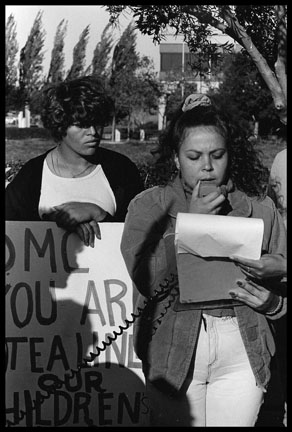
But corporate executives in Silicon Valley were not content with inaction. Their program not only called for extensive changes, but involved a whole new philosophy and public policy for labor/management relations. Under the klieg lights in San Jose’s cavernous convention center, witnesses gave the commission a good first-hand look at the “high performance workplace” – at work teams, labor/management cooperation, the contingent workforce and the new world of “corporate culture and values.”
According to Pat Hill-Hubbard, senior vice president of the American Electronics Association, “employees have become decision-makers and management has practically disappeared.” Doug Henton, representing Joint Venture Silicon Valley, announced, “Unions as they have existed in the past are no longer relevant. Labor law of 40 years ago is not appropriate to 20th century economics.”
Not everyone agreed. “The company always told us that they had to be competitive,” said Romie Manan, describing his years at National Semiconductor. “Increasing the company’s profitability, they said, would increase our job security. That was the purpose of our work teams – to make us efficient and productive. So we became more efficient. Our yield rate on each wafer went from 80 percent to 95 percent.
“Then the company took the ideas contributed by the experienced workforce in Santa Clara, which they got through the team meetings and used them to organize new fabs with inexperienced workers in Arlington, Texas, where wages are much lower. The experienced workers lost their jobs. The team meetings stole our experience and ideas and didn’t give us any power to protect our jobs and families. The company chewed us up and spit us out.”
In the heyday of the UE Electronics Organizing Committee, the plant had almost 10,000 workers, working directly for National Semiconductor. By the time Manan was laid off in the early 1990s, employment had fallen to 7,000. Over half worked for temporary employment agencies, including almost all production and tech workers. Manpower, the temp agency, had an office on the plant floor.
Intel Corporation presented a panel of speakers to shoot Manan down. Phuli Siddiqi, an Intel worker, presented “a worker’s perspective” – that “Intel is a great place to work.” She described “worker ownership of projects and products,” and the company’s program for employee recognition, called “pat on the back.” But she couldn’t deny that Intel jobs were vanishing from Silicon Valley overnight. Personnel Director Kimberley Dyess even declared, “there are no more jobs at Intel. We just have people and work to be done.”
The high level of participation by electronics companies in the Dunlop hearing reflected their unspoken worry that many of their new structures for labor/management cooperation were illegal. At National Semiconductor, according to Manan, the company told workers they had to team up with management in order to defeat the Japanese competition. Fear for their jobs, he said, drove workers to join the teams, which were used to undermine union organizing efforts. Section 8(a)(2) of the National Labor Relations Act prohibits company unions, especially as a way to discourage workers from organizing genuine union. Dyess emphasized that large electronics companies wanted to eliminate section 8(a)(2).
Unions took on another part of the dark underside of high-tech employment – the contingent workforce. Esther Thompson, a janitor who cleaned Apple’s buildings, told commissioners, “I need two jobs because neither pays enough to pay my rent, feed my children and pay my bills.” According to Mike Garcia, president of SEIU Local 1877, “high-technology manufacturing doesn’t create high-wage, high-skill jobs. It patterns itself after the service sector. Contractors in manufacturing compete over who can drive wages and benefits the lowest.” Labor law, he said, should tie contractors to the manufacturers they work for. Big manufacturers control the wages and work lives of contract workers indirectly and they should be responsible for them.
In the only real exchange between commissioners and witnesses, Thomas Kochan, an MIT management professor, and Doug Fraser, retired president of the United Auto Workers, asked industry representatives if they’d agree to accept responsibility for contingent or contract workers or allow workplace committees to represent workers in dealing with management over wages and working conditions. “We’re not looking for someone to represent employees,” responded Deborah Barber from Quantum Corp.
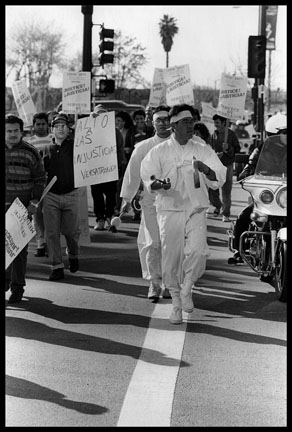
Versatronex strikers marched through downtown San Jose with Korean workers cheated of their pay when their factory closed, and janitors fighting for a union contract, in a show of unity among immigrant workers.
“The concept of representation seems archaic,” added Cheryl Fields-Tyler from the American Electronics Association. When Fraser asked them what alternatives existed for workers unhappy with management decisions, Debra Engel, vice president of 3-Com answered: “the company has an open-door policy.”
The audience laughed.
Conclusion
Perhaps the most telling comment about the state of labor law is that the most effective organizing activity among workers is that which depends on the law the least. While this seems to give up any immediate hope of reform, labor law reform efforts ultimately depend on rising organizing activity on the ground. As Frederick Douglass said, “power concedes nothing without a demand.”
According to Steve Lerner, architect of the national Justice for Janitors strategy, the National Labor Relations Act was only passed in response to large-scale strikes and organizing drives. “Workers will get better laws,” he said, “not because they’re a good idea, but because the level of conflict is so disruptive that a rational system is better.” Douglass called it “thunder and lightening,” and the “awful roar” of the ocean’s waters.
In the fall of 1995, a new leadership was elected to head the AFL-CIO. John Sweeney, who had been president of the Service Employees and a staunch supporter of Justice for Janitors, became the federation’s new president. During the struggle over leadership, Tom Donahue, the interim AFL-CIO president, whom Sweeney defeated, tried to convince convention delegates that the federation was really a narrow “trade union movement.” He attacked his opponents for supporting a “labor movement,” or “social movement,” one that would move away from Washington and into the streets, organizing and speaking for immigrants and low-wage workers, in unions and out of them. Militancy, he said, “marginalizes” the labor movement.
Debating him on the floor of the convention, Sweeney advocated a commitment to use direct action tactics where necessary to organize workers on a much larger scale. In the end, most AFL-CIO delegates saw Donahue’s vision as the source of labor’s marginalization, not the solution to it, and elected Sweeney instead.
In many ways, the Sweeney program for change was more limited than the movement that propelled it into office, seeking to solve most problems by hiring staff and organizing committees and taskforces within the AFL-CIO structure. The strategy was called by one supporter “revolution from above.” Sweeney and his supporters inherited the mental framework that saw organizing drives primarily as the product of paid staff, rather than as an upsurge among workers themselves.
Ten years later, Sweeney’s own union, the Service Employees, left the AFL-CIO along with several others, calling for a greater emphasis on organizing activity. The debate between them, however, revolved primarily around how much money to spend and how many organizers to hire, rather than a deeper challenge to the staff-driven model. The Silicon Valley strategy for uniting community organizations and unions in a grassroots campaign to defend workers as they actively tried to organize moved away from a reliance on the activity of workers themselves. Newer, non-NLRB strategies advocated by SEIU and others often relied on gaining employer neutrality and agreement to card-check recognition. That process many times involved bargains with employers at a very high level, far removed from workers themselves.

It is extremely unlikely that high-tech companies, with their history of total hostility to unions, would ever agree to such measures without a virtual revolution in their workforce. Neither the AFL-CIO nor the Change to Win federation are likely to assign vast new resources to help organize that kind of social movement among workers in the electronics industry in Silicon Valley.
Yet, Silicon Valley is the citadel, the fortress of the country’s most anti-union industry. Overcoming it has the same strategic importance that organizing the steel and auto industries in Pittsburgh and Detroit had in the great industrial union upsurge of the 1930s. For the working class and communities of color in Silicon Valley to assert their own interests and to ensure that economic development meets their needs, the workers in the Valley’s plants must be organized. High-tech industry dominates every aspect of life in Silicon Valley, and its voice is virtually unchallenged on questions of public policy because the workers who have created the Valley’s fabulous wealth have no voice of their own.
Strong, democratic, rank-and-file unions in the electronics plants can give them that voice and in the process change every aspect of political and economic life. The basic decisions on issues of living standards, job relocation, toxic pollution, housing, discrimination and economic development could then be made by the people those decisions affect the most, rather than by employers or public officials, whether well-intentioned or not.
In the 1920s, the steel and auto industries also seemed like insurmountable bastions that unions would never organize. And, yet, a decade later, as a result of a radical social movement based among workers themselves, they were organized in a matter of a few years. This is the challenge of Silicon Valley, the goal sought by its working people for three decades.
Biographical note: David Bacon worked at National Semiconductor for a number of years until he was fired in 1982. He was president of the UE Electronics Organizing Committee from 1978 to 1983 and was the lead UE organizer assigned to the Versatronex strike.
Join us in defending the truth before it’s too late
The future of independent journalism is uncertain, and the consequences of losing it are too grave to ignore. To ensure Truthout remains safe, strong, and free, we need to raise $43,000 in the next 6 days. Every dollar raised goes directly toward the costs of producing news you can trust.
Please give what you can — because by supporting us with a tax-deductible donation, you’re not just preserving a source of news, you’re helping to safeguard what’s left of our democracy.
